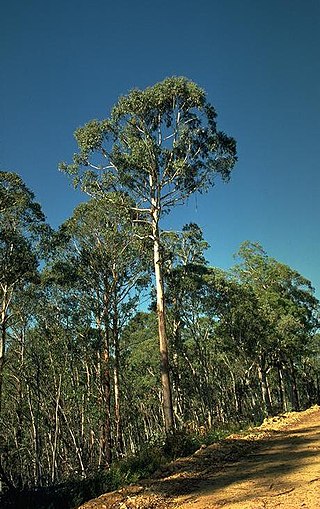
Eucalyptus delegatensis, commonly known as alpine ash, gum-topped stringybark, white-top and in Victoria as woollybutt, is a species of tree that is endemic to southeastern Australia. It has a straight trunk with rough, fibrous to stringy bark on the lower half of the trunk, smooth white bark above, lance-shaped to curved adult leaves, flower buds in groups of between seven and fifteen, white flowers and barrel-shaped or hemispherical fruit.

Eucalyptus baxteri, commonly known as brown stringybark, is a medium-sized tree that is endemic the south-east of Australia. It has rough, stringy bark to the thinnest branches, lance-shaped or curved adult leaves, green to yellow flower buds in groups of between nine and fifteen, and cup-shaped or hemispherical fruit.

Eucalyptus nitida, commonly known as the Smithton peppermint, is a species of tree or mallee that is endemic to Tasmania. It has varying amounts of loose, fibrous or flaky bark, lance-shaped to curved adult leaves, flower buds in groups of nine to fifteen, white flowers and cup-shaped to hemispherical fruit.
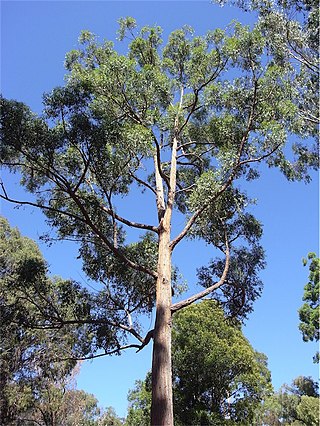
Eucalyptus tindaliae, commonly known as Tindal's stringybark, is a species of tree that is endemic to coastal eastern Australia. It has rough, stringy bark on the trunk and larger branches, lance-shaped to curved adult leaves, flower buds in groups of between nine and fifteen, white flowers and hemispherical fruit.

Eucalyptus blaxlandii, commonly known as Blaxland's stringybark, is a tree that is endemic to south eastern New South Wales. It is a stringybark with lance-shaped adult leaves, flower buds arranged in group of nine or eleven, white flowers and hemispherical fruit.

Eucalyptus ligustrina, commonly known as the privet-leaved stringybark, is a species of shrub, mallee or small tree that is endemic to New South Wales. It has rough, stringy bark, lance-shaped to egg-shaped adult leaves, flower buds in groups of between seven and fifteen, white flowers and hemispherical or shortened spherical fruit.

Eucalyptus porosa, commonly known as mallee box, Quorn mallee or water mallee, is a species of mallee or a tree that is endemic to southern Australia. It has rough, fibrous or flaky bark on the trunk and larger branches, smooth greyish bark above, lance-shaped adult leaves, flower buds in groups of seven, white flowers and barrel-shaped or shortened spherical fruit.

Eucalyptus tenella, commonly known as narrow-leaved stringybark, is a species of small to medium-sized tree that is endemic to New South Wales. It has stringy bark, narrow lance-shaped to linear leaves, flower buds in group of seven to fifteen, white flowers and hemispherical fruit.
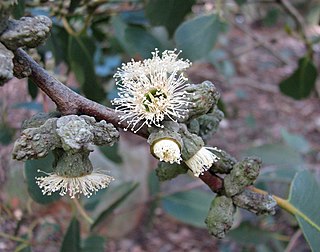
Eucalyptus verrucata, commonly known as Mount Abrupt stringybark, is a species of shrub or a small tree that is endemic to the Grampians in Victoria, Australia. It has smooth bark, rough bark on the base of older trees, egg-shaped to elliptical adult leaves, flower buds usually singly in groups of three in leaf axils, white flowers and cup-shaped or hemispherical fruit.
Eucalyptus × alpina, commonly known as Grampians gum, is a mallee or small tree that is endemic to the Grampians in Victoria, Australia. It has fibrous grey bark near its base and smooth greyish bark higher up. The leaves are broadly lance-shaped to egg-shaped and the plant has very warty buds and fruit. There is disagreement about its name, the Royal Botanic Gardens Victoria referring to it as the Mt Abrupt stringybark.
Eucalyptus victoriana is a species of small to medium-sized tree that is endemic to the Grampians in Victoria, Australia. It has rough, stringy bark on part of the trunk, egg-shaped to lance-shaped adult leaves, flower buds in groups of seven to eleven, white flowers and cup-shaped to hemispherical fruit.

Eucalyptus banksii, commonly known as the Tenterfield woollybutt, is a tree that is endemic to eastern Australia. It has rough fibrous or flaky bark, lance-shaped to curved leaves, flower buds without a pedicel in groups of seven in leaf axils, white flowers and hemispherical to cup-shaped or conical fruit.
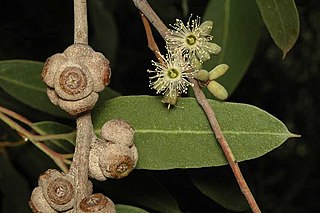
Eucalyptus bensonii, commonly known as Benson's stringybark, is a small tree or mallee that is endemic to New South Wales. It has rough grey or brown stringy bark on the trunk and larger branches, smooth bark on the thinnest branches, broadly lance-shaped to egg-shaped adult leaves, flower buds arranged in groups of seven, nine or eleven, white flowers and cup-shaped or hemispherical fruit in clusters.

Eucalyptus boliviana, commonly known as Bolivia Hill stringybark or Bolivia stringybark is a shrub or a mallee, sometimes a small tree and is endemic to a small area in northern New South Wales. It is a stringybark with four-sides stems, broadly lance-shaped adult leaves, flower buds arranged in groups of seven, yellow flowers and hemispherical to broadly funnel-shaped fruit.

Eucalyptus camfieldii, commonly known as Camfield's stringybark or heart-leaved stringybark, is a species of mallee or small tree that is endemic to New South Wales. It has rough, fibrous and stringy bark, broadly lance-shaped adult leaves, flower buds in groups of about eleven, white flowers and flattened hemispherical fruit. It grows in poor, sandy soil in the Sydney region.
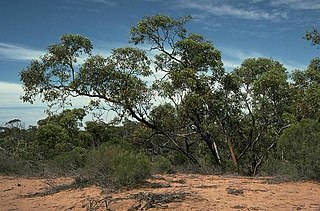
Eucalyptus yumbarrana, commonly known as the Yumbarra mallee is a species of mallee that is endemic to South Australia. It has rough, flaky bark on the lower trunk, smooth bark above, egg-shaped to lance-shaped adult leaves, flower buds in groups of seven, creamy white to yellow flowers and shortened spherical to cup-shaped fruit.

Eucalyptus arenacea, commonly known as the desert stringybark or sand stringybark, is a tree or a mallee that is endemic to south-eastern Australia. It has rough bark to the thinnest branches, lance-shaped or curved adult leaves, club-shaped flower buds arranged in groups of between seven and fifteen, white flowers and hemispherical to more or less spherical fruit.
Eucalyptus imitans, commonly known as the Illawarra stringybark, is a species of small tree that is endemic to New South Wales. It has rough, stringy, greyish bark on the trunk and larger branches, lance-shaped, elliptic to egg-shaped or curved adult leaves, flower buds in groups of between nine and fifteen, white flowers and hemispherical fruit. It is found on near-coastal tablelands inland from the south coast.
Eucalyptus mackintii, commonly known as the blue-crowned stringybark, is a species of medium-sized tree that is endemic to Victoria. It has rough, stringy bark on the trunk and branches, lance-shaped to curved adult leaves, flowers buds in groups of between seven and eleven, white flowers and cup-shaped or hemispherical fruit.
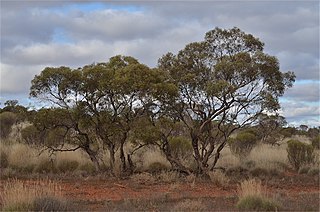
Eucalyptus socialis subsp. socialis, commonly known as the summer red mallee, is a subspecies of mallee that is endemic to inland south-eastern Australia. It usually has rough bark on the base of the trunk, smooth bark above, lance-shaped adult leaves, flower buds in groups of between seven and eleven, pale creamy white flowers and barrel-shaped to urn-shaped or spherical fruit.

















